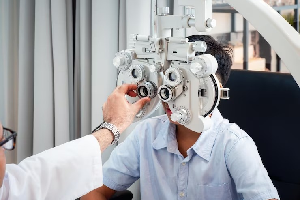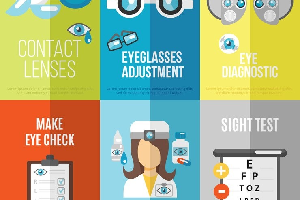Refractive Lens Exchange (RLE), also known as clear lens extraction or lens replacement surgery, is a surgical procedure that involves removing the natural lens of the eye and replacing it with an artificial intraocular lens (IOL) to correct refractive errors. While cataract surgery and RLE share a similar surgical approach, RLE is performed primarily for the purpose of correcting refractive errors, such as nearsightedness, farsightedness, and presbyopia, rather than treating cataracts.
Purpose:
RLE is performed to reduce or eliminate the need for glasses or contact lenses by correcting refractive errors. It is particularly suitable for individuals with significant nearsightedness, farsightedness, or presbyopia who may not be ideal candidates for other refractive procedures like LASIK.
Lens Replacement:
Unlike other refractive surgeries that reshape the cornea, RLE involves replacing the eye’s natural lens with an artificial intraocular lens. This lens can be chosen to correct specific refractive errors, providing clear vision at different distances.



Monofocal IOLs:
Purpose: Monofocal IOLs are designed to provide clear vision at a single focal point, typically either distance or near.
Usage: Patients who choose monofocal IOLs set for distance vision may still need reading glasses for close-up tasks. Conversely, those choosing monofocal IOLs set for near vision may need glasses for distance vision.
Predictability: Monofocal IOLs are known for their predictability and reliability in delivering clear vision at the chosen distance.
Multifocal IOLs:
Purpose: Multifocal IOLs have multiple focal points or zones, allowing patients to see clearly at different distances without the need for glasses.
Usage: These lenses are designed to provide clear vision for both near and far distances simultaneously.
Adjustment Period: Some patients may require an adjustment period to adapt to the different focal points. There might be a slight compromise in contrast sensitivity compared to monofocal lenses.
Reduced Dependence on Glasses: Multifocal IOLs can significantly reduce the need for glasses at various distances.
Accommodating IOLs:
Purpose: Similar to multifocal IOLs, accommodating IOLs are designed to provide clear vision at different distances. However, they work by mimicking the eye’s natural ability to adjust focus (accommodation) as it does when you’re younger.
Usage: Accommodating IOLs can reduce the need for glasses for both near and distance vision.
Adjustment Period: Some patients may experience an adjustment period as the eyes adapt to the accommodating mechanism.
Reduced Dependence on Glasses: Similar to multifocal IOLs, accommodating IOLs aim to reduce the dependence on glasses.
Toric IOLs:
Purpose: Toric IOLs are specifically designed to correct astigmatism, which is a common refractive error caused by an irregular shape of the cornea.
Usage: Patients with astigmatism may benefit from toric IOLs, which can help provide clearer vision without the need for additional procedures to correct astigmatism.
Precision: Toric IOLs are known for their precision in addressing astigmatism and can contribute to better overall visual outcomes.
Refractive Lens Exchange (RLE) is a surgical procedure used to correct vision problems, particularly in individuals who have developed presbyopia or cataracts. Mr Deshmukh, as an eye surgeon, might emphasize several benefits associated with Refractive Lens Exchange:
Improved Vision: RLE aims to improve vision significantly by replacing the eye’s natural lens with an artificial intraocular lens (IOL). This can correct various refractive errors such as nearsightedness, farsightedness, and astigmatism, leading to clearer vision.
Treatment for Presbyopia: For individuals experiencing presbyopia (age-related difficulty focusing on close objects), RLE can be an effective solution. The procedure can help individuals reduce or eliminate the need for reading glasses or bifocals by implanting a multifocal or accommodating lens.
Cataract Correction: RLE can also treat cataracts, a common condition in which the eye’s natural lens becomes cloudy. By removing the cloudy lens and replacing it with a clear artificial lens, vision clarity can be restored.
Reduced Dependence on Glasses: Following Refractive Lens Exchange, many patients experience reduced dependency on glasses or contact lenses for daily activities such as reading, driving, or working on a computer.
Long-Term Results: RLE typically provides long-lasting results. Once the artificial lens is implanted, it remains in place indefinitely, offering improved vision for years without the need for further intervention.
Quick Recovery: The recovery time after RLE is relatively short for many patients. Most individuals can resume their normal activities within a few days to weeks after the surgery.
Versatility: RLE can be tailored to meet individual needs. There are various types of intraocular lenses available, allowing customization to address specific vision issues and preferences.
Mr Deshmukh, as an eye specialist, may discuss these benefits with patients considering Refractive Lens Exchange, highlighting how the procedure can significantly enhance vision, correct refractive errors, and improve overall quality of life. However, it’s important for individuals to consult with their eye doctor to determine if RLE is the right option for their specific eye health needs.
The recovery time after Refractive Lens Exchange (RLE) can vary among individuals, and factors such as the patient’s overall health, the complexity of the procedure, and adherence to postoperative care instructions can influence the recovery process. Here’s a general overview of what to expect during the recovery period after RLE:
Immediate Postoperative Period:
Vision Changes: Some patients experience immediate improvements in vision shortly after RLE. However, it’s common to have some blurriness or haziness immediately following the procedure.
Light Sensitivity: Sensitivity to light may be present, and wearing sunglasses can help alleviate discomfort.
First Few Days:
Rest and Recovery: Resting for the first day or two after surgery is often recommended. Activities that strain the eyes, such as reading or using electronic devices for extended periods, should be limited.
Follow-up Appointment: Patients typically have a follow-up appointment within the first few days to assess the healing process and ensure there are no complications.
First Week:
Return to Normal Activities: Many patients can resume normal daily activities within a week after RLE, although strenuous activities and heavy lifting may still be restricted for a short period.
Eye Drops: The use of prescribed eye drops is crucial during the first week to prevent infection and control inflammation.
First Month:
Clearer Vision: Vision usually continues to improve during the first month, with the majority of patients experiencing significant clarity by this time.
Follow-up Visits: Patients may have additional follow-up appointments to monitor progress and address any concerns.
Long-Term Recovery:
Stabilization of Vision: While vision often improves rapidly after RLE, it may continue to stabilize over several weeks to a few months.
Adaptation to Multifocal Lenses: For patients who have chosen multifocal or accommodating intraocular lenses (IOLs), there may be an adaptation period as the brain adjusts to different focal points for varying distances.
It’s important for patients to follow their surgeon’s postoperative care instructions diligently. This may include using prescribed eye drops, attending scheduled follow-up appointments, and avoiding activities that could compromise the healing process.
1. What is refractive lens exchange (RLE), and how does it differ from laser eye surgery or cataract surgery?
Refractive lens exchange involves replacing the eye’s natural lens with an artificial intraocular lens (IOL) to correct refractive errors. It differs from laser eye surgery, which reshapes the cornea, and cataract surgery, which replaces a cloudy lens with an IOL.
2. Who is an ideal candidate for refractive lens exchange performed by Mr Deshmukh?
Individuals over 50 with refractive errors like nearsightedness, farsightedness, or presbyopia, and those seeking to reduce dependence on glasses or contacts, may benefit from RLE. Mr Deshmukh assesses candidacy during a thorough evaluation.
3. What are the advantages of choosing refractive lens exchange by Mr Deshmukh over other vision correction procedures?
RLE can correct multiple vision problems simultaneously, offering long-term visual clarity. Mr Deshmukh expertise ensures personalized treatment and optimal outcomes for patients seeking improved vision.
4. What types of intraocular lenses (IOLs) are available for refractive lens exchange, and how does Mr Deshmukh determine the most suitable lens for each patient?
Various IOL options exist, including multifocal, toric, and accommodating lenses. Mr Deshmukh evaluates each patient’s eye health, lifestyle, and vision goals to recommend the most suitable IOL for their needs.
5. How long does it take to recover from refractive lens exchange, and what can patients expect during the recovery period?
Recovery after RLE is typically swift. Patients may experience improved vision within a few days, with minor discomfort or temporary vision fluctuations. Mr Deshmukh provides post-operative guidance to ensure a smooth recovery process.










